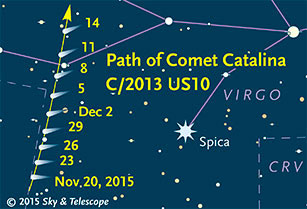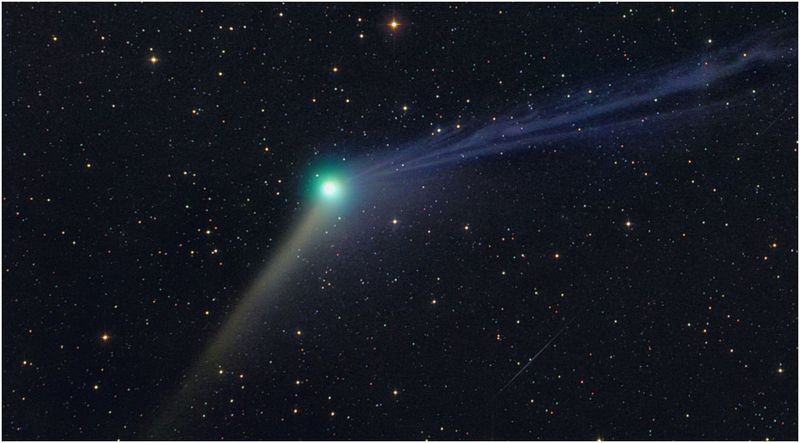
C/2013 US10 is an Oort Cloud comet with a steeply inclined orbit of 149 degrees. It's
spent much of its time lately below the plane of the solar system, out of view of Northern
Hemisphere skywatchers. After solar conjunction at mid-month, it will transition to
northern skies and arc over the inner planets. On January 12, 2016, the comet comes closest
to Earth at 66.9 million miles (107.7 million km).
NASA / JPL
Discovered by the Catalina Sky Survey on Halloween 2013, the comet received the "US10" designation because it was initially thought to be an asteroid in a short period orbit. After more observations to refine its path and additional photographs that revealed telltale comet fuzz, astronomers realized they'd run into a denizen from the Oort Cloud, knocked our way by the close passage of some nameless star long ago. At the time of discovery, Catalina glowed at only 19th magnitude some 7.7 a.u. from Earth. Typical of new arrivals, it dove into the inner solar system on a steeply inclined orbit.

C/2013 US10 spends its first few weeks after conjunction climbing northward through Virgo near Spica. Ticks mark its position at 0h Universal Time every three days. Stars are plotted to 6th magnitude. Click on the image for a large, color PDF map.
Sky & Telescope
The comet pursues a northerly track through Virgo when it returns at dawn around November 24th, appearing 8 deg high in the southeastern sky 70 minutes before sunrise. By the 28th, it will have climbed to 10 deg in a dark sky shortly before the start of dawn.
Now for the bad news. A bright Moon will put a temporary damper on the comet's rise to fame from November 24th through December 3rd. From there on out, though, it's smooth sailing until the Moon returns for Round two at the winter solstice.
Catalina glides northward at nearly 1 degree per day in late December as it crosses from Virgo into Bootes on a beeline for Arcturus. On the morning of January 1st, the comet skims 1/2 deg southwest of that orange luminary in a remarkable conjunction highlighting the arrival of the new year. Photo anyone?
http://www.skyandtelescope.com/observing/comet-catalina-sails-into-northern-skies111120151111/


